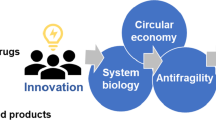Abstract
This paper attempts to answer the question: What is the dollar value that can be placed on a single plant species now growing in the United States, should it become extinct? Based on available botanical and prescription survey data and data on global studies of plants as a source of new drugs for human use, the value of a single species is calculated to be $203 million, and the total value of plant species growing in the United States that may become extinct by the year 2000 AD is calculated to be about $3,248 billion.
Similar content being viewed by others
Literature Cited
Anonymous. 1980. Herb sales up in health food market. Herbalgram, Feb., p. 1.
Anonymous. 1981. The Lilly Digest. Eli Lilly and Co., Indianapolis, IN.
Ayensu, E. S., and R. A. DeFilipps. 1978. Endangered and Threatened Plants of the United States. Smithsonian Institution, Washington, DC.
Cronquist, A. 1981. An Integrated System of Classification of Flowering Plants. Columbia Univ. Press, New York.
Douros, J. D., and M. Suffhess. 1980. The National Cancer Institute’s natural products antineoplastic development program. Recent Results Cancer Res. 70: 21–24.
Farnsworth, N. R., and A. S. Bingel. 1977. Problems and prospects of discovering new drugs from higher plants by pharmacological screening. In H. Wagner and P. Wolff, ed, New Natural Products with Pharmacological, Biological or Therapeutical Activity, p. 1–22. Springer-Verlag, New York.
—, and R. W. Morris. 1976. Higher plants-the sleeping giant of drug development. Amer. J. Pharm. 148: 46–52.
Gossel, T. A., and J. R. Wuest. 1981. Over the counter laxatives. U.S. Pharmacist 6: 20, 22-25, 83.
Kartesz, J. T., and R. Kartesz. 1980. A Synonymized Checklist of the Vascular Flora of the United States, Canada, and Greenland. Univ. North Carolina Press, Chapel Hill, NC.
Melville, R. 1978. As quoted in Ayensu and DeFilipps above, p. 1.
Schultes, R. E. 1972. The future of plants as sources of new biodynamic compounds. In T. Swain, ed, Plants in the Development of Modern Medicine, p. 103–124. Harvard Univ Press, Cambridge, MA.
Tippo, O., and W. L. Stern. 1977. Humanistic Botany. Norton, New York.
Tyler, V. E. 1979. Plight of plant-drug research in the United States today. Econ. Bot. 33: 377–383.
Author information
Authors and Affiliations
Rights and permissions
About this article
Cite this article
Farnsworth, N.R., Soejarto, D.D. Potential consequence of plant extinction in the United States on the current and future availability of prescription drugs. Econ Bot 39, 231–240 (1985). https://doi.org/10.1007/BF02858792
Received:
Accepted:
Issue Date:
DOI: https://doi.org/10.1007/BF02858792




